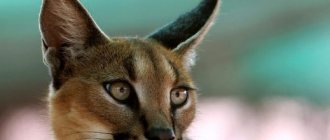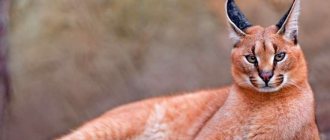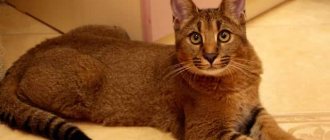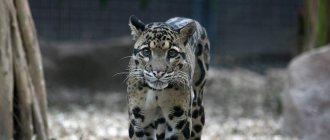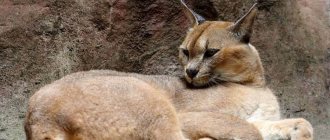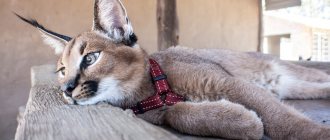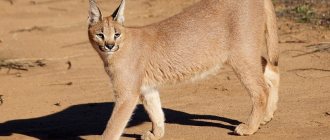There is much that is ambiguous about caracals. For example, the name of this animal is translated from Turkic as “black ear,” although only the long tassels on its ears are black. Another name – “steppe lynx” – is also not entirely correct, since the caracal is closer to the puma and the African serval. Although the caracal was domesticated in ancient times and is now bred in nurseries, it is still not considered a pet. Moreover, even a wild caracal can be tamed and trained.
By the way, we have a wonderful separate article about the African serval.
There is a lot of gossip around domestic caracals, some of which exaggerate the difficulties of keeping these beauties, while others downplay them. One thing is indisputable: despite the high cost and specific conditions of detention, the animal is capable of bringing a lot of joy and becoming a source of pride for its owners.
The caracal at home is not a tribute to the fashion for wild predators. The history of domestication of the caracal goes back more than two thousand years, although during this time it managed to change its role.
What is a caracal or desert lynx?
The caracal is a wild cat that lives in Africa, the Middle East, and Asia. In nature, animals live in rock crevices or abandoned burrows of other animals. They actively hunt at night in the foothills, steppes, deserts or savannas. During the day, animals mostly sleep.
Important : like cheetahs, the desert lynx stores its prey in nature on the crowns of trees.
In nature, there are only 9 subspecies of caracals, and some of them are on the verge of extinction. In Russia, they are found in the wild only in Dagestan, and then in small numbers (about 100 individuals).
Historical reference
Cats of the Caracal genus live in the deserts and savannas of Africa, Central Asia, the Arabian Peninsula and the Caspian Sea coast since ancient times. It is believed that the historical homeland of this animal is Türkiye. The word Karakal means “black ears” in Turkish.
Since ancient times, steppe caracals have been tamed and used by the inhabitants of Asia and Africa.
- Excavations in Egypt have yielded paintings of caracals and bronze sculptures, as well as embalmed carcasses. This means that caracals occupied an important place in the life of the Egyptians.
- In China, emperors gave caracals as valuable gifts.
- In India, caracals have long been used for hunting small game.
- In Asia, this breed was used to help hunt game.
Interesting fact! In Iran, caracals were entertainment for wealthy gambling people. Animals were tamed, trained to hunt birds, and entered into competitions based on the number of birds caught in a jump.
The fact is that caracals are wonderful jumpers; they can jump up to 3 meters in the air to catch flying birds. Up to ten pigeons can be caught in this way at a time. The winner was the one whose cat knocked out the most birds from the jump. All these facts prove that the domestication of caracals is not something new, but rather began centuries ago.
Discovery of the breed
Just 40 years ago, representatives of this breed could only be found in the wild desert or in zoos. Translated from Turkish, the caracal cat translates as “black ears.” There is a legend that the breed originated in ancient times, when African hunters took the steppe lynx as a hunting companion. Wealthier hunters took cheetahs with them. But nevertheless, the steppe cat perfectly caught pheasants, antelopes, hares and peacocks. At the moment, not many steppe lynxes live at home. Most of them, after all, live in the wild.
But the caracal breed was officially recognized by world organizations only in the 20th century, and since then it has had certain standards. These exotic cats have an unusual and attractive color and tufts on their ears. They are easy to train.
Where does the wild cat caracal live: habitat of the steppe lynx
As noted earlier, the desert lynx caracal lives in Africa and Asia. They prefer arid areas, clay deserts, and semi-deserts.
What does it look like
Externally, the caracal looks like a steppe lynx. But unlike her, they have a longer tail. This breed of cat has round pupils, luxurious black tufts on the ears, large limbs, and a muscular body.
Dimensions
According to world standards, the desert lynx has a graceful body, ranging in size from 65 to 100 cm in length. The height at the withers varies between 40-50 cm. The length of the cat’s skull is 11 cm, and the width at the cheekbones is 7.5 cm. The weight of an adult varies from 12 to 20 kg. Breed standard
Appearance
The serval, also called the bush cat, has the pride and grace of an African predator. Its size is small compared to other African brothers and simply gigantic if we equate it to an ordinary domestic cat. The weight of spotted pets ranges from 8-18 kg. Height is 40-65 cm, and body length can reach 130 cm.
The head is relatively small, the muzzle is not elongated, but the ears are quite large, set high, and well-furred inside. The bridge of the nose and nose are wide. The eyes are almond-shaped and large. Servals are truly top models in the cat world. Their limbs are the longest in relation to the body, with the hind legs being slightly longer than the front ones.
The coat is short, thick and shiny. The main color is golden brown. On the chest, belly and face there are lighter areas, almost white, and the main decoration of the cat is contrasting black spots arranged in stripes. The color may have some differences depending on the geographical homeland. Servals from the steppe regions are distinguished by large spots and a light background, while forest cats are darker.
Serval hybrids
In captivity, servals sometimes mate with ordinary domestic cats. Based on such hybrids, a new breed was developed, which was called Savannah. There was also information about the appearance of a hypoallergenic breed with the beautiful name Asher. Subsequently, they turned out to be the same shrouds, the price of which was greatly exaggerated by the scammers. In addition, matings of bush cats with steppe lynxes and caracals are often quite successful. As a result, the so-called servicals or caravals are born.
Character and behavioral characteristics
When purchasing, it is worth remembering that Caracal cats are predators. Therefore, a lot of attention is paid to raising kittens. The main principles in their upbringing are consistency and subordination. The pet owner must clearly state his conditions, showing who is boss in the house.
The Caracal cats themselves are different:
- phlegmatic calm;
- good nature;
- passion for games of various types;
- owner's instinct. This animal gets along well with other pets (cats, dogs), but is aggressive towards other people’s animals and will drive them out of its territory;
- curiosity. Hearing footsteps outside the door, the animal will immediately rush towards them to see who has come. Also, during a walk, hearing a rustling in the bushes, the cat will show interest.
Despite its formidable appearance, this breed has a soft and docile character. Pets love to be scratched behind the ears, stroked, and simply cannot stand being alone. In other words, the domestic caracal requires increased attention.
Important: the wild steppe cat gets along well with teenage children and other pets.
How to protect yourself from enemies
In the wild, the steppe lynx actively defends itself from its enemies (steppe wolves). But domesticated individuals are more peaceful, and they have practically no self-defense instincts. Of course, if you seriously offend a cat, he may bare his teeth or scratch.
What does it eat in natural conditions?
Under natural conditions, steppe cats eat: rodents (gerbils, jerboas, gophers), hares. Sometimes they are not averse to eating hedgehogs, insects, reptiles and even porcupines. In addition, caracals also feed on plant foods: grass, grapes. They may not drink water for several days in their natural habitat, being content with the amount of liquid they get from food.
Our advice
For those who have dealt with puppies, raising a caracal will not be difficult. The animal requires a strict, but fair and affectionate attitude. You cannot shout at your pet, and physical punishment is unacceptable. However, unwanted behavior must be stopped immediately.
Even at a very early age, a kitten should not climb onto the dining table, try food from plates and pots, or chew wires and shoes. Remove all valuable and fragile items, as well as anything that could be dangerous for your pet: cords, plastic bags, household chemicals, poisonous houseplants.
The pet easily gets used to walking on a harness. Caracals should be walked away from dog parks. A predator should not be allowed to roam without a leash outside a closed enclosure.
Keeping a caracal at home
The domestic caracal cat requires proper care and maintenance. It is worth noting that keeping such a pet is far from a cheap pleasure. The steppe lynx eats several times more than an ordinary cat, and it requires more serious care.
It is not recommended to keep a domestic lynx in small city apartments, as the animal needs space to play. It is best to buy such pets for owners of country houses. You can even build an aviary for them on your personal plot to stay in the fresh air during the warm season. But animals do not tolerate cold well. Therefore, they must spend the winter in a well-heated and ventilated room.
Caring for a caracal at home
As for proper care, the karakula is necessary:
- comb once a week. During the molting period, which falls in the summer, the animal is combed more often;
- bathe when heavily soiled, but not more than once a month;
- Animals' claws are trimmed in a veterinary clinic using a laser. On the hind legs, you can sharpen them yourself at home;
- Once a week, pets' eyes and ears are cleaned.
Attention: the caracal needs fresh air. Therefore, they need to be walked regularly on a leash.
This breed of cat needs to be vaccinated (against rabies and various infectious diseases) as a preventive measure and visit a veterinarian every six months for an examination.
Attention: doodles love to take water treatments and happily splash around in the bathtub or outdoor pool with rubber toys.
Nutrition
Having decided to feed the caracal with ready-made dry food, preference is given to super premium products. The diet of a steppe cat must include:
- fresh turkey, chicken, beef or boiled meat. But it is strictly forbidden to give them pork;
- vegetables such as carrots, cabbage, pumpkin and zucchini. Caracals eat vegetables with pleasure if they are added to meat;
- chicken eggs;
- dairy products.
Attention : you should not feed steppe cats with cereals and soups. For this breed of cat there is nothing healthy or nutritious in these products. Milk and smoked meats are also excluded from the diet.
The animal is fed twice a day at the same time. If the cat does not eat everything the first time, you should not leave the food in the plate. The plate should be removed immediately after eating, its contents should be thrown away, and the dishes should be washed thoroughly. This animal drinks a lot of water, so the drinking bowl is monitored with special attention.
Attention : once a week it is recommended for pets to have fasting days.
Health
By nature, caracals are endowed with good health. But sometimes they get sick too. You should not self-medicate desert lynx, as this can lead to disastrous consequences. Having noticed the first ailments of your pet, you should immediately seek help from a veterinarian.
What to look for when buying a kitten
Before choosing the kitten itself, you need to look at its parents and other adult relatives.
This will help you get an idea of what he will look like as an adult and what his character will be like. Ask the breeders what the cats eat and whether the parents have had any illnesses.
Each kitten must have a veterinary passport with stamps from the state veterinary clinic on vaccinations against at least rabies and panleukemia. Without the stamp, state vaccination clinics are not valid!
A healthy little caracal should have:
- shiny wool;
- clear eyes without streaks or tears;
- dry nose without discharge;
- clean “pants” on the hind legs and a place under the tail.
Ask the breeders to show how the kitten plays, allows itself to be brushed, and has its ears or paws examined.
A resistant and unplayful animal is much more difficult to tame. If the cat is offered sterilized, it is worth finding out who performed the operation.
If one caracal is offered for sale, ask for documents about its origin. The purchase and sale of Red Book species, which include the Turkmen subspecies of caracal, is prohibited by law.
How much does a caracal cost?
Having your own predator is not a cheap pleasure. Prices for domesticated caracals in nurseries start at $6,500 for a neutered kitten. Animals suitable for breeding will be even more expensive.
Sometimes they offer to buy cheaper cats. These may be untamed caracals caught in Africa or Asia, and they will require much more effort to train. Such animals are dangerous because they can carry exotic diseases.
How and in which nurseries to buy a caracal kitten
Having decided to purchase a domestic caracal, you need to select proven and well-established nurseries. To do this, just read reviews on the Internet and compare the cost of kittens on different sites. When purchasing a kitten, be sure to check the breeding license. The seller is also obliged to issue the buyer a veterinary certificate. passport (which must contain all vaccinations) and a sales contract.
What is the price
In Russia, caracal kittens are sold for an average of 500 thousand rubles. From some breeders you can buy 100-150 thousand cheaper or, conversely, more expensive. The final price depends on the purebred, the location of the nursery, the age and health of the animal, the reputation of the breeder, and the availability of related documents. Purebreds are more expensive, domestic cat-caracal hybrids are cheaper. The smaller the baby, the higher its cost and vice versa. Particularly valuable cats cost from 10,000 to 50,000 US dollars.
Interesting facts about the breed
There are a lot of interesting facts about this cat breed:
- The caracal is a very fast and agile predator;
- it is very similar in appearance to a lynx, but has a longer tail;
- During the hunt, the animal behaves very carefully and quietly. The caracal can growl like a leopard, and if it is caught near its prey, it hisses and growls like an ordinary domestic cat;
- the animal has good eyesight and sensitive hearing, thanks to which it is an excellent night hunter in the wild;
- in nature they live alone, and sit in their homes for a long time;
- The Caracal cat raises its offspring on its own. Before giving birth, she manages to make several secluded places to live;
- in the wild, cats need long tufts on their ears for camouflage;
- An animal's ears laid back indicate a threat. Straight ears indicate that the animal is in a good mood and listens carefully to its owner;
- when meeting with their representatives of the genus, steppe cats communicate using ear movements;
- cats are excellent climbers and jumpers in trees, and can easily jump to a height of more than 2 meters;
- caracals cannot run for long because of their long limbs, so they hunt by jumping;
- The life expectancy of a steppe cat in the wild is 10-15 years.
In conclusion, it is worth noting that with the purchase of a caracal kitten, positive emotions and good mood will appear in your life. This pet knows how to be grateful. He loves to spend his leisure time with his owners, playing games or just sitting on their laps. This domestic steppe lynx will bring variety and a lot of pleasant and positive moments into the life of its owners.
Upbringing
Although the domesticated Caracal cat breed does not show aggression and is friendly, it is not recommended to have one if the family has a preschool-age child. There are certain rules for handling these animals, which only older children can learn.
These cats will not cause any trouble if the owners devote enough time to raising them. It must be said that his techniques are similar to those practiced when training puppies. The pet must understand that he cannot do the following:
- climb on the table;
- chew electrical wires, clothes and shoes;
- eat from the owners' plates.
Smart animals easily get used to the tray. It must be located in some secluded place. A deep container should be filled with silica gel or wood granules.
During educational activities, it is necessary to be strict, but under no circumstances should you beat the animal. While the kitten is small, you need to take care of its safety: put all household chemicals, poisonous plants, cords and plastic bags out of its reach.


